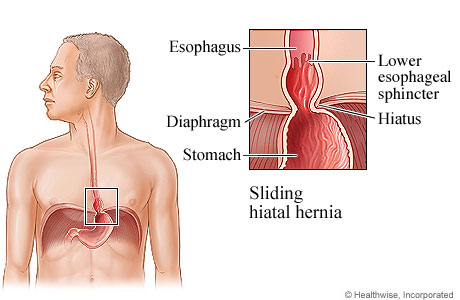Sliding Hiatal Hernia
Current as of: May 5, 2017
Author: Healthwise Staff
Medical Review: Adam Husney, MD - Family Medicine & Arvydas D. Vanagunas, MD - Gastroenterology

The esophagus connects to the stomach at an opening in the diaphragm called the hiatus. The lower esophageal sphincter (LES), which is normally at the same level as the diaphragm, keeps stomach contents (food, acid, and other digestive juices) from backing up (or refluxing) into the esophagus.
But when a sliding hiatal hernia is present, part of the stomach moves up through the hiatus and into the chest cavity. This pushes the lower esophageal sphincter (LES) up into the chest cavity away from the hiatus. Away from the hiatus, the LES loses the support that it needs from the diaphragm to stay closed. This raises the risk for symptoms of heartburn and gastroesophageal reflux disease.
Current as of: May 5, 2017
Author: Healthwise Staff
Medical Review: Adam Husney, MD - Family Medicine & Arvydas D. Vanagunas, MD - Gastroenterology
This information does not replace the advice of a doctor. Healthwise, Incorporated, disclaims any warranty or liability for your use of this information. Your use of this information means that you agree to the Terms of Use. Learn how we develop our content.
To learn more about Healthwise, visit Healthwise.org.
© 1995-2018 Healthwise, Incorporated. Healthwise, Healthwise for every health decision, and the Healthwise logo are trademarks of Healthwise, Incorporated.